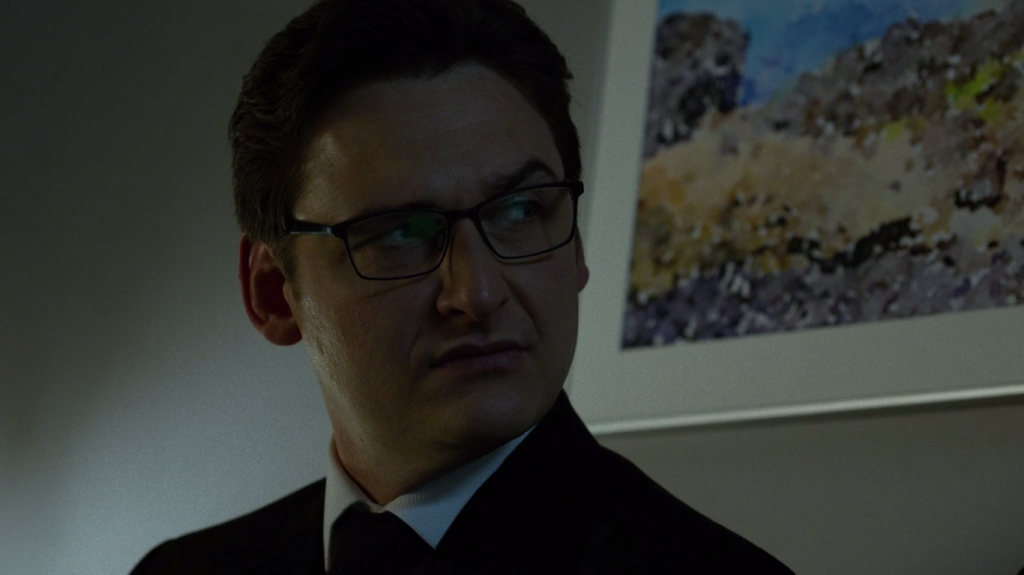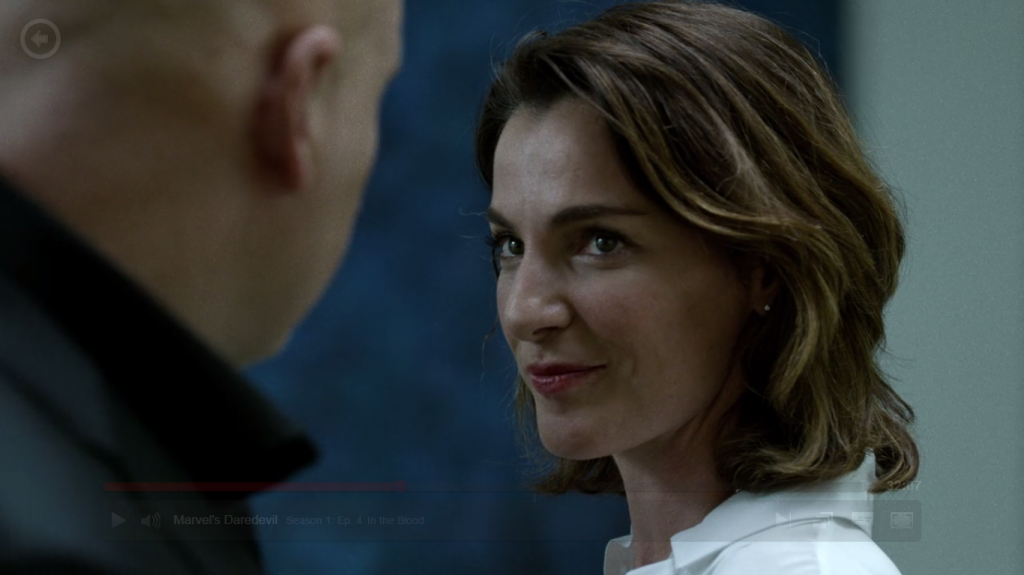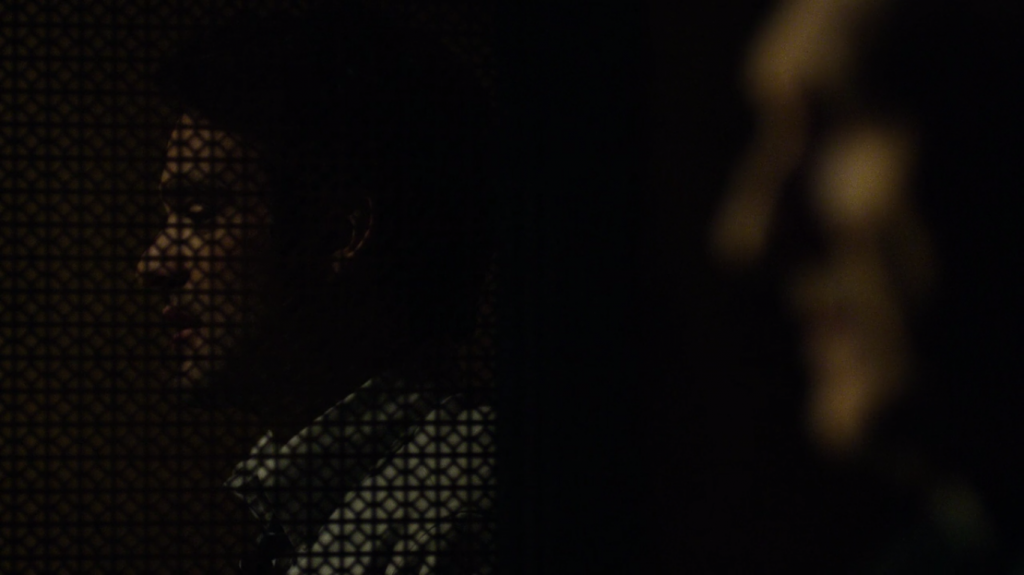
Are you there, God? It’s me, Dom. Why did you give your creations the ability to stream whole seasons of television in one sitting like this? Did you think about the consequences? What it does to water cooler conversation or how it affects pacing in the medium? Or is this one of those things like “fire” or “asbestos” where you just came up with some shit and figured we’d make it work somehow?
So, I didn’t learn from my last binge experience and dove right into a new one. I’ve been up since 2 a.m. and, with the exception of two bathroom breaks and one quick run across the street for dumplings, have watched all thirteen episodes of Marvel’s Daredevil on Netflix straight through. I’m a lot less tired than I anticipated I’d be, the journey less difficult thanks to the show actually being really good. As I write this, It hasn’t even been 24 hours since the episodes went up, so we’ll keep S P O I L E R S as light as humanly possible. It’s thirteen hours of pretty densely plotted television, and there’s a lot to unpack, both positive and negative, so we’re also going to eschew the regular structure to try to highlight as many interesting, noteworthy aspects of the show as we can.
The Basics
Marvel’s Daredevil is a pretty straightforward, fun series if you are even remotely familiar with the source material, but I imagine for new audiences, the type of viewer drawn to the Marvel brand by The Avengers and the like, it significantly broadens the spectrum of what the MCU is capable of. DD still takes place in the same cinematic world as Thor and Iron Man, but it operates on a street level that allows them to sidestep the biggest problems in Agents of S.H.I.E.L.D. while exploring themes some of the brighter areas of the mega-franchise just aren’t built to play with. Rather than adhere tightly to any one Daredevil story arc, the show weaves in important elements of the mythos with a tweaked take on his origin, creating a non-linear narrative loosely reminiscent of Batman Begins.
Charlie Cox brings blind attorney/fledgling vigilante Matthew Murdock to life, the latest in a long line of surprisingly perfect casting decisions from Marvel. He’s just starting out, running a new law practice alongside his legal partner and best friend Foggy Nelson (Elden Henson) by day and kicking the living shit out of human traffickers while wearing a makeshift costume by night. The narrative plays hopscotch with memory and flashback, visiting Matt’s personal history (from childhood up to now) at appropriate times but largely focusing on the present and the ongoing gentrification of Hell’s Kitchen in a New York ravaged by the big, bad Chitauri battle that every post-Avengers film treats like 9/11. Taking advantage of the serialized format, DD doesn’t have to cram everything they want to accomplish into two hours, so the entire season is allowed to breathe and writhe the way a year of the ongoing comic might, leading to more positive results than negative ones. It’s an immersive corner of the Marvel world, one you’ll want to spend a lot of time in, despite the inherently tragic, film noir fucked up-ness of it all.
“Better Than Batfleck! *CLAP CLAP CLAPCLAPCLAP*”
While it may seem foolhardy to compare this show to the 2003 film, it’s very difficult not to. It’s such a categorical improvement on everything Mark Steven Johnson and crew got wrong the first time around that you’ll be cheering for what the show isn’t as much as what it turns out to be. Our boy Maximilian already went the fuck in on this garbage movie, with its nu-metal musical accompaniment, questionable writing, and borderline offensive visuals, but its wrongheaded execution makes sense, given how weirdly it translates Sam Raimi’s Spidey films. The ’03 Daredevil is as much a product of its time as anything. Luckily for us, Evanescence and wire work kung fu have gone out the window, and Breaking Bad-esque long form storytelling is king.
Here are the four big ways this show owns its predecessor:
1. Instead of bombarding the viewer with an over-the-top CGI interface to represent the heightened senses that came with Murdock’s super-blindness, DD uses brilliant, well placed sound design and reliable editing patterns to get the same moments across. There’s one notable scene that shows us an approximation of his POV, but the rest of the time we’re presented with Murdock’s perspective without being assaulted by it. We replace scenes of rain soaked, rooftop make out sessions with Murdock saying things like “I can hear your bones shift when you breathe,” which, let’s keep it 100, is WAY more romantic.
2. Realism isn’t everything, especially in a show about a blind lawyer ninja with toxic waste powers, but the ’03 film presented a world that looked fake as fuck at all times, like someone tried to recreate Frank Miller art as a long PS1 cut scene. The cinematography and production design for the show are top notch, striking a palatable balance between the moody cinema verite of Nolan’s Bat films with purposeful splashes of unreal color in the lighting schemes. Sickly greens and lush purples serve to heighten and exaggerate the gray morality the show trades in, all the while adding a layer of pulp and zeal to the proceedings.
3. The action, for the most part, feels coherent and logical. Murdock’s building hopping has more in common with parkour running than Affleck’s unfortunate Spider-Man style rooftop slinging, and the hand to hand combat feels considerably less balletic. Every single person who watches it will point this out, but the “one take” fight at the end of “Cut Man” is one for the books. It sells the exhaustion and pain a relatively regular crime fighter like Daredevil would theoretically experience, given his limitations. That it does this without extreme close-ups of Ben Affleck dry chewing vicodin is pretty laudable.
4. Speaking of Affleck, one of the most frustrating things in the ’03 film is how awkwardly they try to show us what it’s like to be blind. Murdock sleeping in a deprivation tank and a lot of weird shots of Affleck making clueless facial expressions. Here, the devil is in the details, finding innocuous ways to remind us that Murdock can’t traditionally “see,” whether through pithy punchlines or little touches like his cell phone ringtones being the the name of the person calling.
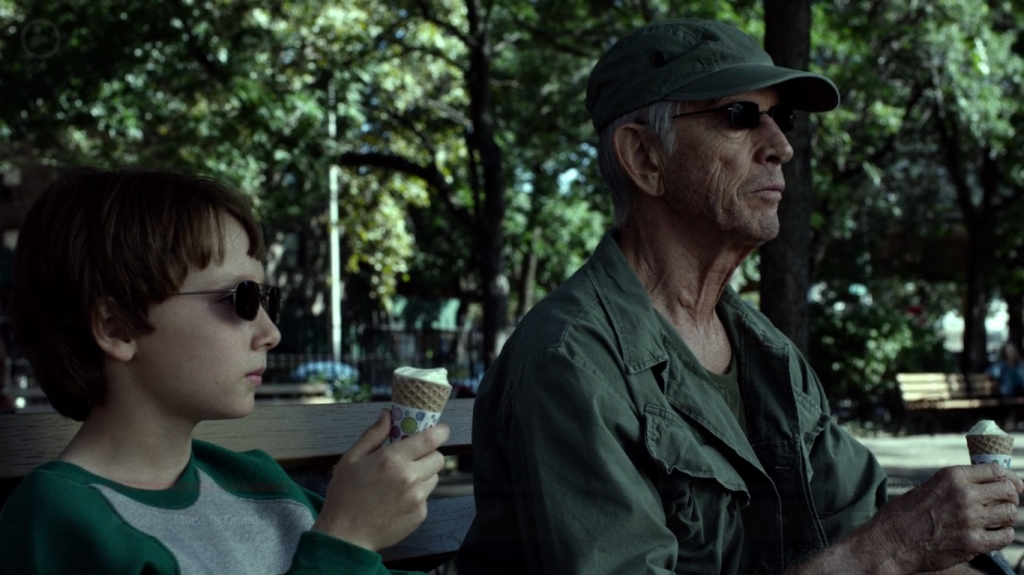
Urban Cowboy‘s Scott Glenn as blind ninja Stick, a big breath of fresh air in the second half of the season.
Dreamcast (And I Ain’t Talkin Shenmue)
All of the properties underneath the MCU banner are beloved for their brilliant casting decisions, but DD really takes the cake. None of the cast members are people the average geek would include on a fantasy fan cast list, but each performer embodies the core of their character with such ease. The sharp characterization (from fellow Whedonite writers like Drew Goddard, Steven S. DeKnight, and Doug Petrie) helps, to be sure, but there’s so much vitality and chemistry between the main players that the world we’re introduced feels fully formed from the opening moments of the first episode.
Charlie Cox’s Matt Murdock strikes just the right balance between impassioned crusader and careless dickhead, managing to elicit equal amounts of sympathy and scorn. He broods, but he injects levity and charisma at all the right moments to save the show from tumbling down a grim dark rabbit hole. His interplay with Elden Henson’s Foggy Nelson is one of the show’s two big love stories. (The other, surprisingly, being between Vincent D’Onofrio’s Fisk and Ayelet Zurer’s Vanessa.) D’Onofrio’s performance is a tour de force, reconciling multiple interpretations of his character with ease while leaping from peak to trough on the Jack Nicholson Scenery Chewing Comic Villain Scale. He’s comic book-y enough to stand out, but layered enough to feel like a genuine noir tragedy.
No one sticks out as not pulling their dramatic or comedic weight, and even the bit players, like Fisk’s right hand man John Wesley (played with arch villainy by Toby Leonard Moore) who steals every single scene he is in by making this amazing facial expression:
They take some smart chances, like race bending Ben Urich with veteran thesp Vondie Curtis Hall, or taking Leland Owsley (The Owl in the comics) and recasting him as a perpetually annoyed money manager played by Bob Gunton. Gunton is endlessly entertaining, providing Jeffrey Tambor-esque comic relief, all the while maintaining an air of persistent sleaze. I doubt it will come to pass, but this should be the first comic based television property to win Best Ensemble at the SAG Awards.
What is the opposite of the Bechdel test?
As great as the cast is, the women on this show are given short shrift. Rosario Dawson (as Kinda-Night Nurse Claire Temple), Deborah Ann Woll (as Karen Page) and the aforementioned Zurer (as Vanessa) all deliver amazing performances, but they’re each shackled to the male characters they’re forced to orbit around. This problem definitely stems from the source material, as the Daredevil comics have always possessed a somewhat toxic preoccupation with masculinity (largely the result of the long shadow Frank Miller casts over the franchise).
The show doesn’t do much to move away from that issue, but the story it presents is as much about fathers as anything else, with its twin protagonists, Murdock and Fisk, drawn from two very different paternal influences. We see some of Fisk’s mother, but Murdock’s is conspicuous in her absence (something they may be saving for an eventual adaptation of classic DD story “Born Again”). There’s also a pleasant dearth of the wanton fridging the comic has become so adept at providing over the years. None of Murdock’s conquests get impaled on any sais, but it doesn’t excuse how little the women seem to exist outside of their relation to their male counterparts.
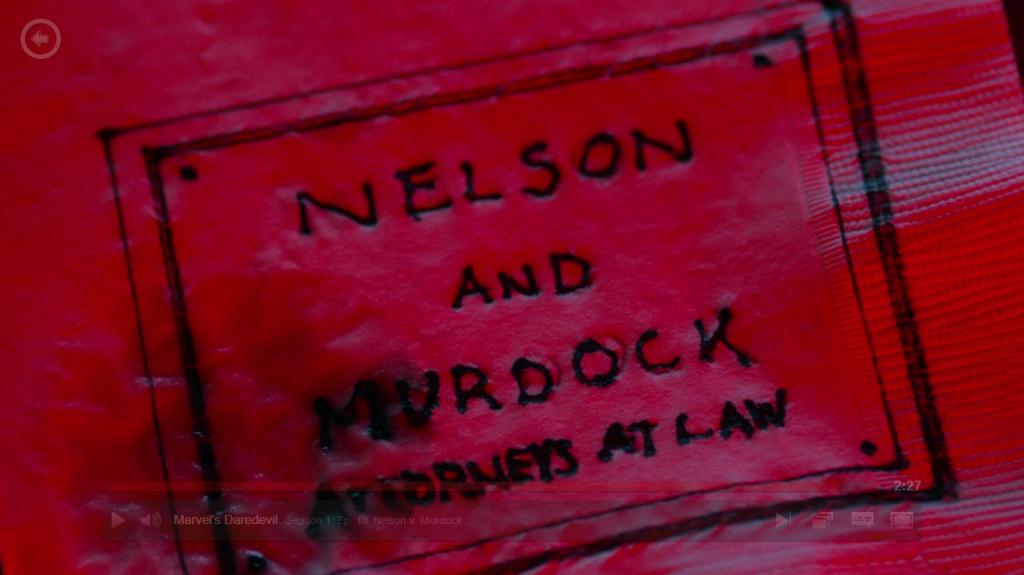
A drink is spilled onto the bar napkin design for the Nelson & Murdock logo, the stain tarnishing Matt’s name like the blood on his hands.
T H E M E S
There’s a shot that gets repeated over multiple episodes, a close-up of Murdock’s face, from below, as another character is framed in the reflection of his red shades, the pace of their heartbeat’s thump functioning as a human lie detector. Cox conveys subtle disappointment or relieved comfort with the imperceptible curl of his lip, or minor shoulder movement. It’s the kind of smart, efficient visual storytelling the show is so good at, and it ties into the recurring themes of duplicity, integrity, and the difficulty of ascertaining right versus wrong.
DD explores these issues through the prism of Hell’s Kitchen, a city split between two law-flouting men who want to make it a better place. Murdock is willing to beat the shit out of anyone he crosses paths with if it somehow leads to the extinction of human trafficking, murder, and graft, while Fisk is perfectly fine with profiting off of all three if it brings him the requisite power to reinvent his hometown into something worthy of his ambitions. He’s not just a Bond villain who wants to control everything. He’s a man who really believes in his own cause, and the chief conflicts of the show are the collateral damage, the truth of what happens to the rest of us when there’s no one to stop careless, powerful men.
The flip side is even more tragic, as we’re regularly presented with the unavoidable consequences of standing up to injustice. No character in the narrative is rewarded for doing the right thing, and most of the show’s deaths are the direct result of otherwise good intentions. There’s an ambiguity to Murdock’s exploits, painting him as less of a hero and more a fucked up person whose proclivities happen to properly line up with the side of the angels. Every Daredevil comic plays around with religious imagery, but that internal conflict is played so well here. When Murdock looks into a priest’s eyes, pleading for understanding, you feel it. When he asks “Why did He put the devil in me?” it has weight. There’s no idealism here. No one is clean, even the ones trying to do the best.
It’s the cost of doing good and the false nobility of living with necessary evil.
Should You Binge This?
It depends. One of the reasons it’s so easy to binge a show like this is it feels like one really long movie, but the creators saw fit to structure it both ways. If you want to watch the whole thing in one go like I did, it’ll be a little like reading a trade paperback front to back, as the season easily breaks into three or four comic book-length story arcs. If you want to watch a couple here and there, or one a week, that is also fine, as the show still has cliffhangers and smart chapter breaks.
The downside of the binge method is you will notice far more problems than you might watching it piecemeal. Some repetitive plot structures will present themselves, as will tired devices (like using a purposefully blatant music choice in any of the time setting flashbacks). Moments that are designed to remind you about the last episode will feel egregious given the fact that you just got finished watching whatever they’re alluding to. Using the Netflix model of thirteen episodes each pushing one full hour, the season feels a little too long. Once you get to the finishing stretch, it feels more dragged out than dramatically necessary and probably would have benefited from fewer episodes (like Agent Carter‘s eight or Better Call Saul‘s ten), or just episodes that shaved ten to fifteen minutes here and there.
Whichever way you choose to watch, you must watch. It’s great television that feels like a more honest, appropriate adaptation of Marvel’s source material than almost anything they’ve made since Iron Man, and it sets up a bevy of new opportunities for the studio. Franchises that might not work as big summer blockbusters, like The Punisher or Moon Knight could be absolute slam dunks in the Netflix Marvel Knights model and can serve to tell richer, more measured tales than their movie counterparts are capable of.
Marvel’s Daredevil is the first of a new breed. The only downside is we have three more sister series to get through before we get another season in Hell’s Kitchen.
Marvel’s Daredevil is streaming now on Netflix.


